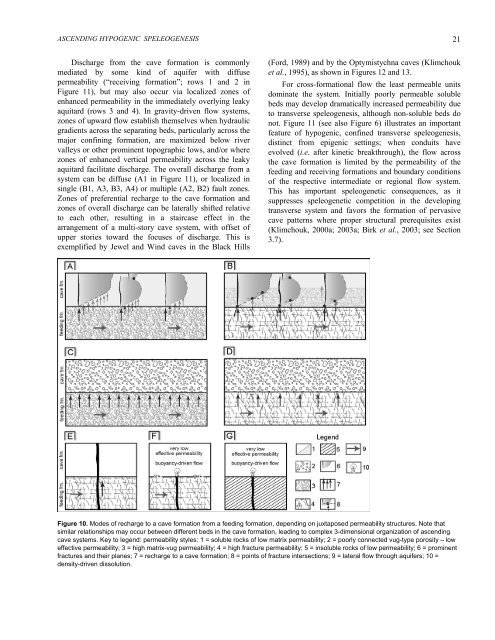Download PDF - Speleogenesis
Download PDF - Speleogenesis
Download PDF - Speleogenesis
You also want an ePaper? Increase the reach of your titles
YUMPU automatically turns print PDFs into web optimized ePapers that Google loves.
ASCENDING HYPOGENIC SPELEOGENESIS<br />
Discharge from the cave formation is commonly<br />
mediated by some kind of aquifer with diffuse<br />
permeability (“receiving formation”; rows 1 and 2 in<br />
Figure 11), but may also occur via localized zones of<br />
enhanced permeability in the immediately overlying leaky<br />
aquitard (rows 3 and 4). In gravity-driven flow systems,<br />
zones of upward flow establish themselves when hydraulic<br />
gradients across the separating beds, particularly across the<br />
major confining formation, are maximized below river<br />
valleys or other prominent topographic lows, and/or where<br />
zones of enhanced vertical permeability across the leaky<br />
aquitard facilitate discharge. The overall discharge from a<br />
system can be diffuse (A1 in Figure 11), or localized in<br />
single (B1, A3, B3, A4) or multiple (A2, B2) fault zones.<br />
Zones of preferential recharge to the cave formation and<br />
zones of overall discharge can be laterally shifted relative<br />
to each other, resulting in a staircase effect in the<br />
arrangement of a multi-story cave system, with offset of<br />
upper stories toward the focuses of discharge. This is<br />
exemplified by Jewel and Wind caves in the Black Hills<br />
(Ford, 1989) and by the Optymistychna caves (Klimchouk<br />
et al., 1995), as shown in Figures 12 and 13.<br />
For cross-formational flow the least permeable units<br />
dominate the system. Initially poorly permeable soluble<br />
beds may develop dramatically increased permeability due<br />
to transverse speleogenesis, although non-soluble beds do<br />
not. Figure 11 (see also Figure 6) illustrates an important<br />
feature of hypogenic, confined transverse speleogenesis,<br />
distinct from epigenic settings; when conduits have<br />
evolved (i.e. after kinetic breakthrough), the flow across<br />
the cave formation is limited by the permeability of the<br />
feeding and receiving formations and boundary conditions<br />
of the respective intermediate or regional flow system.<br />
This has important speleogenetic consequences, as it<br />
suppresses speleogenetic competition in the developing<br />
transverse system and favors the formation of pervasive<br />
cave patterns where proper structural prerequisites exist<br />
(Klimchouk, 2000a; 2003a; Birk et al., 2003; see Section<br />
3.7).<br />
Figure 10. Modes of recharge to a cave formation from a feeding formation, depending on juxtaposed permeability structures. Note that<br />
similar relationships may occur between different beds in the cave formation, leading to complex 3-dimensional organization of ascending<br />
cave systems. Key to legend: permeability styles: 1 = soluble rocks of low matrix permeability; 2 = poorly connected vug-type porosity – low<br />
effective permeability; 3 = high matrix-vug permeability; 4 = high fracture permeability; 5 = insoluble rocks of low permeability; 6 = prominent<br />
fractures and their planes; 7 = recharge to a cave formation; 8 = points of fracture intersections; 9 = lateral flow through aquifers; 10 =<br />
density-driven dissolution.<br />
21
















